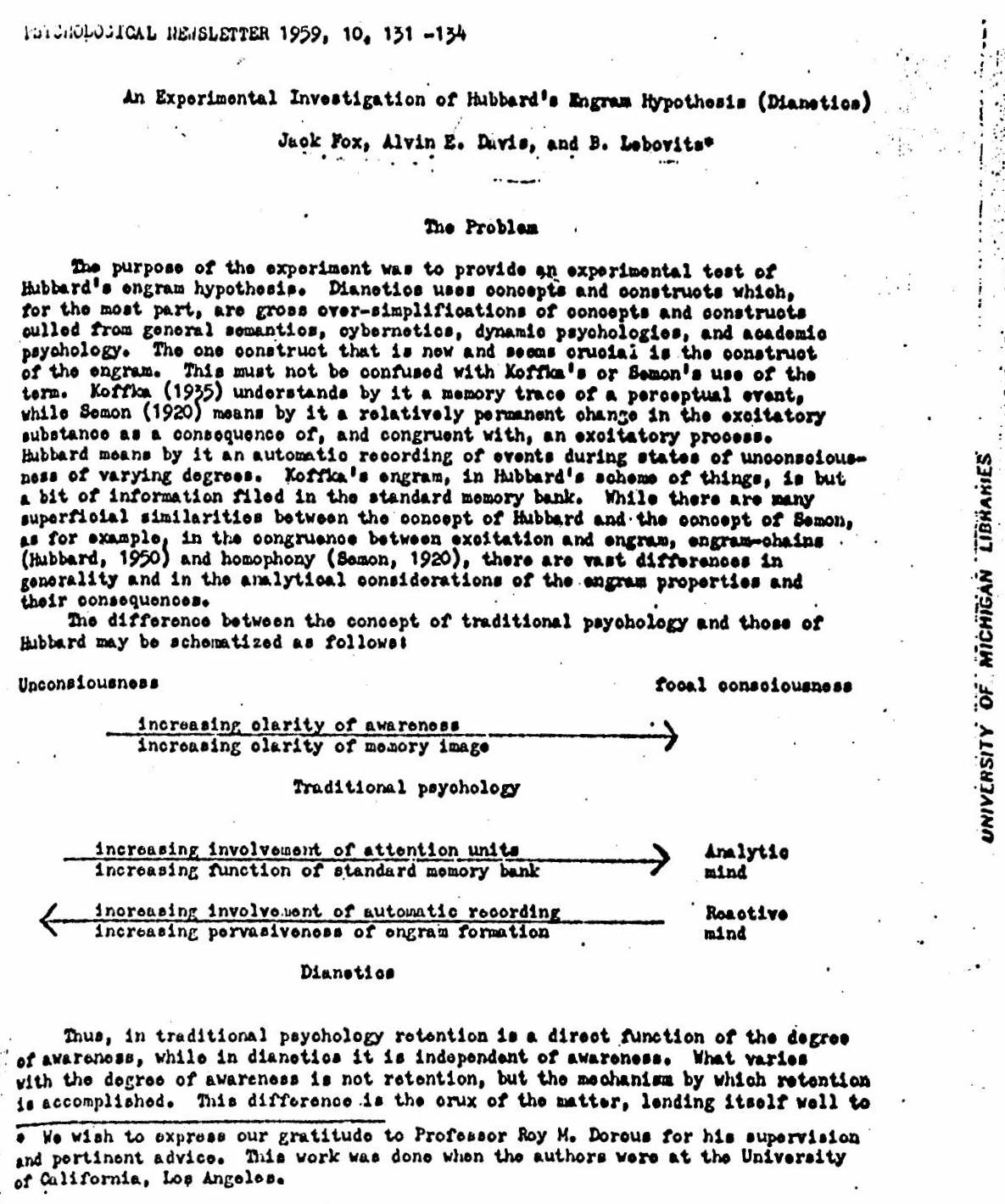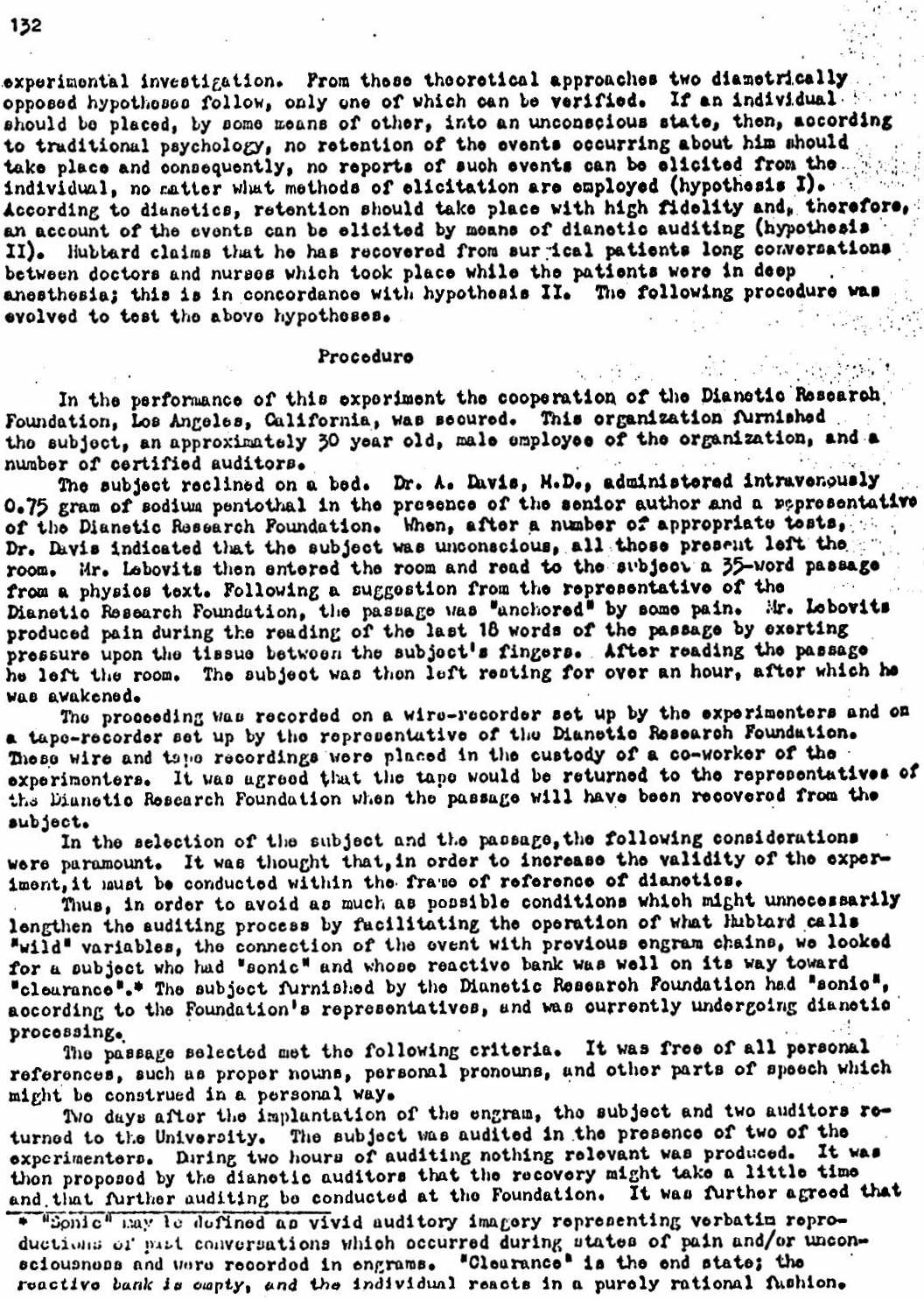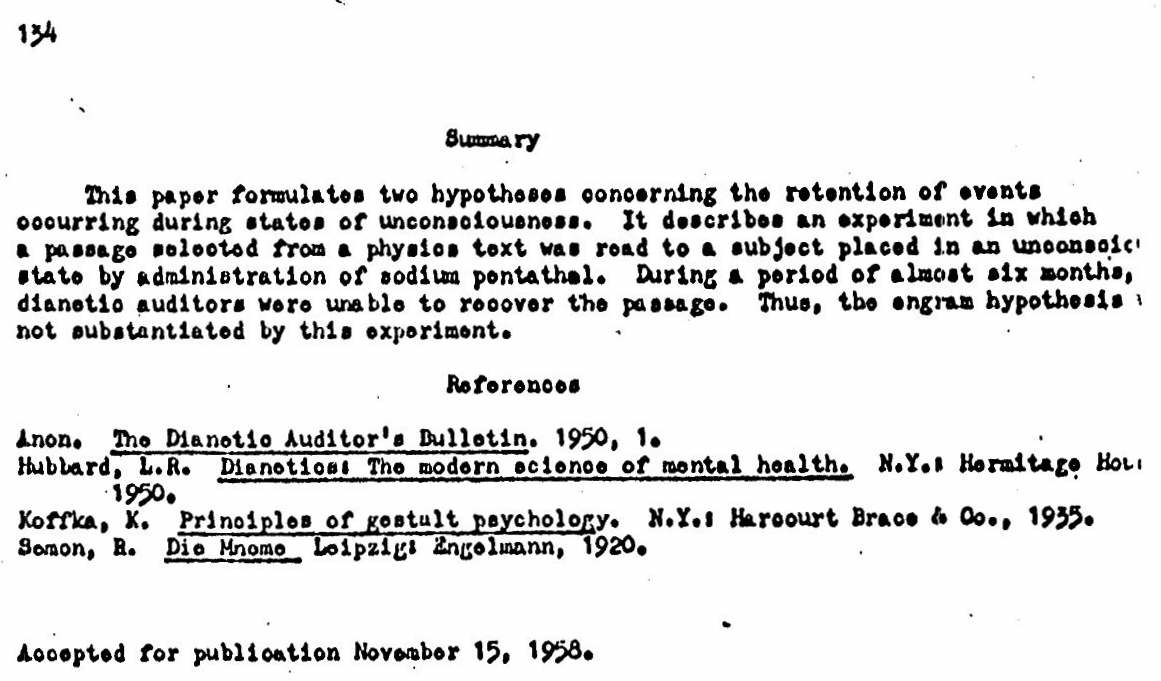
This is from Steven Johnson's book, Mind Wide Open.274pp.
Quote: Steven Johnson:
"Freud was also right to emphasise the role of unconscious urges. Emotions are processed in a part of the brain called the amygdala. From "intuiting a spouse's bad mood from a subtle look in her eye" to controlling phobic reactions, "your amygdala directs your appraisal of the world", says Johnson. And when we have an irrational fear, the amygdala is in conflict with the rational neocortex, just as in Freud's notion of a clash between our civilised superego and our primal id. But Freud might have been wrong about one thing. Neuroscience suggests that the talking cure can actually make some traumatic experiences worse: "reliving events only makes them stronger". end quote.
See review of dianetics by Scientific American HERE: A Clinical Trial of Dianetic Theory
In cooperation with the Dianetic Research Foundation, Los Angeles, California, AND using Hubbards own proposal on the theory of Dianetics IN Dianetics - which stated that if you drugged someone with sodium pentothol to render them unconcious and and then created some pain, and spoke to the person, you would create an engram.
Anything said to the person during the incident could be recovered..claimed Hubbard.
The clinicians involved, then drugged her, applied the pain... and read a passage to her from a physics textbook..
The Hubbard's Dianeticists then tried to get the information out of the gal using "Dianetics Auditing" - for six months.
Here are images of the original documents about this "Test" These should be collected, and printed out, by anyone wishing to EXIT a Scientologist from Scientology..
PAGE 1 Dianetics Clinical Trial

PAGE 2 Dianetics Clinical Trial

PAGE 3 Dianetics Clinical Trial

PAGE 4 Dianetics Clinical Trial

An Experimental Investigation of Hubbard's Engram Hypothesis
(Dianetics)
Jack Fox, Alvin E. Davis, and B. Lebovit
Psychological Newsletter, 1959, 10 131-134
The purpose of the experiment was to provide an experimental test of Hubbard's engram hypothesis. Dianetics uses concepts and constructs which, for the most part, are gross over-simplifications of concepts and constructs culled from general semantics, cybernetics, dynamic psychologies, and academic psychology. The one construct that is new and seems crucial is the construct of the engram. This must not be confused with Koffka's or Semon's use of the term. Koffka (1935) understands by it a memory trace of a perceptual event, while Semon (1920) understands by it a relatively permanent change in the excitatory substance as a consequence of, and congruent with, an excitatory process. Hubbard means by it an automatic recording of events during states of unconsciousness of varying degrees. Koffka's engram, in Hubbard's scheme of things, is but a bit of information filed in the standard memory bank. While there are many superficial similarities between the concept of Hubbard and the concept of Semon, as for example in the congruence between excitation and engram, engram-chains (Hubbard, 1950) and homophony (Semon, 1920), there are vast differences in generality and the anlytical considerations of the engram properties and their consequences.
The difference between the concept of traditional psychology and those of Hubbard may be schematized as follows:
| Unconsiousness | Focal consciousness | |
| increasing clarity of awareness | ||
| ----------------------------------> | ||
| increasing clarity of memory image |
| increasing involvements of attention units | ||
| ------------------------------------------------> | Analytic Mind | |
| increasing function of standard memory bank |
| increasing involvements of automatic recording | |
| Reactive Mind | <------------------------------------------------- |
| increasing pervasiveness of engram formation |
Procedure
In the performance of this experiment the cooperation of the Dianetic Research Foundation, Los Angeles, California, was secured. This organization furnished the subject, an approximately 30 year old, male employee of the organization, and a number of certified auditors.
The subject reclined on a bed. Dr. A. Davis, M.D., administered intravenously 0.75 gram of sodium pentothal in the presence of the senior author and a representative of the Dianetic Research Foundation. When, after a number of appropriate tests, Dr. Davis indicated that the subject was unconscious, all those present left the room. Mr Lebovits then entered the room and read to the subject a 35-word passage from a physics text. Following a suggestion from a representative of the Dianetic Research Foundation, the passage was "anchored" by some pain. Mr. Lebovits produced pain during the reading of the last 18 words of the passage by exerting pressure upon the tissue between the subject's fingers. After reading the passage he left the room. The subject was left resting for over an hour, after which he was awakened.
The proceeding was recorded on a wire-recorder set up by the experimenters and on a tape-recorder set up by the representative of the Dianetic Research Foundation. These wire and tape recordings were placed in the custody of a co-worker of the experimenters. It was agreed that the tape would be returned to the representatives of the Dianetic Research Foundation when the passage will have been recovered from the subject.
In the selection of the subject and the passage, the following considerations were paramount. It was thought that, in order to increase the validity of the experiment, it must be conducted within the frame of reference of dianetics.
Thus, in order to avoid as much as possible conditions which might unnecessarily lengthen the auditing process by facilitiating the operation of what Hubbard calls "wild" variables, the connection of the event with the previous engram chains, we looked for a subject who had "sonic" and whose reactive bank was well on the way toward "clearance". The subject furnished by the Dianetic Foundation had "sonic", according to the Foundation's representatives, and was currently undergoing dianetic processing.
["Sonic" may be defined as vivid auditory imagery representing verbatim reproductions of past conversations which occurred during states of pain and/or unconsciousness and were recorded in engrams. "Clearance" is the end state; the reactive bank is empty, and the individual reacts in a purely natural fashion.]
The passage selected met the following criteria. It was free of all personal references, such as proper nouns, personal pronouns, and other parts of speech which might be construed in a personal way.
Two days after the implantation of the engram, the subject and the two auditors returned to the University. The subject was audited in the presence of two of the experimenters. During two hours of auditing nothing relevant was produced. It was then proposed by the dianetic auditors that the recovery might take a little time and that further auditing be done at the Foundation. It was further agreed that a report would be forwarded to the experimenters as soon as the engram was contacted, and that the subject and auditors would return to the University to record the "running" of the engram so that it may be compared with the wire which was made during the implantation.
Results
Approximately one and one-half months later the first report was received, covering 31 hours of auditing. Since the report is too long, only the summary covering the last few sessions will be quoted.
"The sessions following have been run in very much the same way. Additional phrases that have turned up are as follows:To the above might be added that the subject as well as the auditors had ample opportunity observe that Mr Lebovits carried a physics text under his arm.'You can remember this.'
'To supplement the equation we need three additional factors.'
'Number one is the result of prime plus three.'
'Number two is that result put into prime again.'
'Number three is the combination of the other two.'
'Therefore where the equation is supplemented by additional factors, three components need to be considered.'
'Number one is the result of the prime plus three added to the original equation.'
'Number three is the combination of factors one and two.'
'Then to supplement the equation three additional factors must be considered.'
'Number one is the result of the prime plus three'.
'Number two is the............of the prime.'
'Then when the equation is supplemented by additional factors three factors need to be considered.'
'Number two is the..........'
'I don't care what you say to me.'
'I won't do it. Not for you or anybody else.' (Latched on to earlier engram which was run to reduction.)It is not possible at this time to confirm any of the phrases which have been so far contacted to be the control phrases.
The sense of reality of the pre-clear is weak in that he experiences full sonic in the prenatal bank but has no sonic in the control engram."
Comparison with the selected passage shows that none of the above-quoted phrases, nor any other phrases quoted in the report, bear any relationship at all to the selected passage.
Since the reception of the first interim report, in November 1950, the experimenter tried frequently and repeatedly to obtain further reports, but so far without success.
Discussion
Such results as these are contrary to hypothesis II, but they tend to confirm hypothesis I.
Although the negative results do not preclude success at another time and although the N in this case is only one, it is the opinion of the investigators that the negative results of the experiment are fairly conclusive since the experimental conditions were well controlled. Moreover, the nature of the experiment is not one that lends itself to the use of many subjects, as it involves careful selection of the subjects, medical administration of the anaesthetics, and medical supervision of the anaesthetized subject.
"Summary: This paper formulates two hypothesis concerning the retention of events occuring during a state of unconsciousness. It describes an experiment in which a passage read from a physics text was read to a subject placed in an unconscious state by administration of sodium pentathal. During a period of almost six months, Dianetic Auditors were unable to recover the passage. Thus the Engram Hypothesis is not substantiated by this experiment.
References:
Anon: The Dianetic Auditor's Bulletin. 1950 1
Hubbard, L. R. Dianetics: The Modern Science of Mental Health NY hermitage 1950
Koffka, K. Principles of Gestalt Psychology< 1935br>
Somon, R. Die Mnome, Leipzig Englemann 1920
Accepted for Publication November 15, 1958
If Dianetics is the basis of Scientology, and Dianetics is proven by Scientific method to be a FRAUD, then all that comes after it, including litigation, depopularization of those who expose them, was and is a fraud, also. Sincerely
Arnie Lerma
6045 N 26th Road
Arlington VA 22207
Questions? call 703 241 1498
After Dianetics, Hubbard legalized robbery, by calling it belief - he called that Scientology\
Excerpt from: The Mind Possessed by William Sargant
Chapter one - "The Mind Under Stress"
page 17
"One other important fact must be mentioned. If any patient is subjected to repeated abreaction on the couch, as in psychoanalysis and other more intensive forms of psychotherapy, and if this occurs over a period of months or years, he often becomes increasingly sensitive and suggestible to the therapists suggestions and interpretations of symptoms. A hypnoid state of brain activity may result. Patients may come to feel that in some way they are in the hands of a person of almost divine wisdom; they avidly accept suggestions from the therapist about altering their behavior, which would have become more unacceptable to them in their more normal state of mind. Quite bizarre interpretations are accepted and false memories are believed as facts if they fit in with the analysts own beliefs. It is necessary to emphasize as strongly as possible that in this stage of brain activity, brought about by continually stirring up the nervous system, and whether or not the transmarginal inhibitory collapse phase is finally reached, the patient can become sensitized, suggestible (or, rarely, pathologically unsuggestible), and often much too willing to adopt new attitudes and new behavior patterns which Freudians refer to this sort of thing ocurring in psychoanalysis as the 'transference situation' or as 'gaining insight.' I intend this book to show how it happens in states of supposed religious possession."
pages 35, 36
"The mind sometimes splits in such a way that an apparently well-balanced person begins to live in two different mental worlds, one of which is dominated by a hypnoid and highly suggestible brain activity. His previous intellectual training and habits of rational thought have no influence in preventing the acceptance of ideas which he would normally find repellant or even patently nonsensical. The new constellation of beliefs then coexists with his more usual habit of critically examining new ideas, and accepting or rejecting them in the light of his prevailing outlook, his experience and and his educational and intellectual background. His newly set of acquired ideas is shut off from and unrelated, or even diametrically opposed, to his other ideas, which have developed in a state of clear and critical consciousness. For reasons which he cannot explain but which have to do with the equivelant, paradoxical and ultraparadoxical phases of brain activity discussed in Chapter 1, white is suddenly black, friends are enemies and enemies are friends, small matters are more important than larger issues, or perhaps nothing seems to matter anymore at all. Irrational attitudes and beliefs now live cheek by jowl with rational and critical thinking about other topics. When this hysterical split mindedness in partial, hysterical behavior, hypnoid states, uncritical belief and sudden conversion can occur in people whose thinking processes are still normal in other respects, through their behavior may seem more bizarre and incomprehensible to detached observers."
More on William Sargant:
Why you never got that promotion ( page written for recovering scientologists )
Sources Hubbard stole from to create scientology